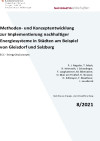Suchergebnisse
Innovativer Mottenschutz für Schafwolldämmstoffe

Schafwolle gilt als ausgezeichneter Dämmstoff im Hausbau und bei der Altbau-Sanierung. Leider wird Schafwolle häufig mit problematischen Insektiziden gegen Mottenbefall ausgerüstet und somit als "Naturprodukt" entwertet. Für das wohngesunde "Haus der Zukunft" wurde ein innovativer, ungefährlicher und effektiver Mottenschutz für Schafwolldämmstoffe entwickelt.
REVITALISING with S.A.M. - Synergy Activation Modules

Case study for the development of modules that allow for the revitalisation of existing structures without interruption of utilization (two studies, one realisation).
Solar cooling machine with a cooling power of 2 kW

Development and building of a prototype of a coolingmachine with a cooling power of 2 kW, tests and optimizing on a test facility, connection to a solar unit and utilization for air conditioning.
e-retrofit kit - tool kit for passive house retrofit
Development of an internet-based tool for passive house retrofit für - target group social housing companies. Actualization of tool after test and evaluation in case-studies. dissemination activities in austria.
Sorptionsgestütztes Kühl- und Entfeuchtungsgerät
Klimatisieren mit der Sonne in Kombination mit komfortabler kontrollierter Wohnraum-lüftung bald auch für Hausbauer möglich und erschwinglich. Mit Hilfe eines neuartigen Bauteils soll der DEC Klimatisierung zum Durchbruch verholfen werden.
Building and modernising with "Building of Tomorrow"
The project BauModern turned to non-profit and commercial housing developers and real estate managements. In close co-operation with the federations of the housing and real estate economy has been achieved that builders are informed about market-suited innovative technologies and concepts and use these strengthened for their projects both in the new building and in the refurbishment.
Methoden- und Konzeptentwicklung zur Implementierung nachhaltiger Energiesysteme in Städten am Beispiel von Gleisdorf und Salzburg (ECC - EnergyCityConcepts)

Im gegenständlichen Projektvorhaben werden anhand zweier konkreter Modellregionen (Kleinstadt Gleisdorf und urbanes Stadtquartier Salzburg-Schallmoos) neue methodische Herangehensweisen (interdisziplinäre Energieraumplanung, Modellbildung und Simulation) entwickelt und erprobt. Die beiden Modellregionen verbindet dabei das ambitionierte politische Bekenntnis zu einer 100 % erneuerbaren bzw. CO2-neutralen Energieversorgung.
Schriftenreihe
8/2021
P. J. Nageler, T. Mach, R. Heimrath, I. Schardinger, F. Langhammer, M. Biberacher, O. Mair am Tinkhof, H. Strasser, H. Edtmayer, F. Mauthner, I. Leusbrock
Herausgeber: BMK
Deutsch, 141 Seiten
Downloads zur Publikation
Building of Tomorrow for the construction industry
Dissemination of results of the research initiative "Building of tomorrow" for two specific target groups - master builder and installer - implementation in further vocational training concepts
e80^3-Buildings - Sub project 4: Demonstration object
Alongside the realisation of the plus energy building in Kapfenberg, a demonstration project is scheduled to be created that accomplishes an economically viable and technically innovative solution for the future.
Monitoring Mehrfamilienhäuser "Tonpfeifengasse"

Messtechnische Begleitung und Bewertung der Funktionsweise von Bauteilaktivierung als Speicher für Umweltenergien am Beispiel der Wohnhausanlage Tonpfeiffengasse.
Schriftenreihe
18/2023
S. Handler, G. Haslinger
Herausgeber: BMK
Deutsch, 72 Seiten
Downloads zur Publikation
REVITALISIERUNG mit S.A.M. - Synergie aktivierende Module

Fallspezifisch entwickelte Synergie aktivierende Module zur Revitalisierung bestehender Baustrukturen ohne Nutzungsunterbrechung (zwei Projekte, eine Ausführung).
Sozialer Wohnbau, Holz-Passivhaus am Mühlweg, 1210 Wien
Mehrgeschossiger Wohnbau für 70 Wohneinheiten bzw. rd. 200 Bewohner in Holzmassivbauweise und Passivhausstandard, einer möglichst ökologischen nachhaltigen Projektstrategie im Kostenrahmen des sozialen Wohnbaus, Mühlweg, 1210 Wien. Industrielle Vorfertigung, Mieterbetreuung, Evaluierung
ÖkoInform - Informationsknoten für ökologisches Bauen

Informationsknoten zur verstärkten Integration ökologischer Materialien und nachwachsender Rohstoffe im "Haus der Zukunft"
Passivhaus-Sanierungsbauteilkatalog. Zweite Ausbaustufe
Bauteilkatalog für Gebäudesanierungen auf Passivhausstandard für Baualtersklassen von Gründerzeit bis 80er Jahre. Besonderes Augenmerk auf die Sanierung erdberührter Bauteile. Integration von Lüftungsanlagen. Konstruktionen mit zeichnerischer Darstellung, bauphysikalischen Kenndaten und ökologischer Bewertung über den gesamten Lebenslauf. Das Projekt lieferte einen Beitrag zu "Multiplizierbare Sanierungskonzepte aller Baualtersklassen auf Passivhaustandard und/oder vergleichbare Standards".
OPEN HEAT GRID - Open Heat Grids in urban hybrid systems
The primary research topic of OPEN HEAT GRID was to investigate the possibilities of enforcing the feed-in of industrial waste heat into existing district heating networks. The project results show that excess heat is not for free: despite minimal variable costs, the investment costs need to satisfy usual payback periods. The analysis shows that there is no need for a regulation in the sense of a feed-in obligation or market liberalization. However, from an economic point of view, information asymmetries exist, which may lead to irrational decisions.
WEIZconnected - Gebäudeübergreifender Energieaustausch
Projektgegenstand ist die Konzeption, Entwicklung und Demonstration bzw. der Testbetrieb eines Gesamtsystems des gebäudeübergreifenden Energieaustausches (Strom) und der gebäudeintegrierten Produktion bei Gebäuden unterschiedlicher Nutzungsart (Gewerbe/Büro/Labor, Wohnbau). Zwei Pilotanlagen mit je unterschiedlichen Voraussetzungen und Zielen werden realisiert.
Sunny Energy Building: ENERGYbase - Bürohaus der Zukunft
Mit der Errichtung dieses zukunftsweisenden Kompetenzzentrums für Erneuerbare Energie setzt der Wiener Wirtschaftsförderungsfonds (WWFF) neue Maßstäbe bei der Entwicklung Energie optimierter Büroimmobilien. Auf 7.500 m² stehen Unternehmen sowie Forschungs- und Bildungseinrichtungen aus dem Zukunftsbereich der Erneuerbaren Energien modernste Büroflächen zur Verfügung.
DALEC - Day- and Artificial Light with Energy Calculation
Entwicklung eines Online-Konzeptanalysetool für ArchitektInnen, BauingenieurInnen, LichtplanerInnen und Bauherrn, welches trotz einer einfachen Handhabung und kurzen Berechnungszeiten, die komplexen lichttechnischen und thermischen Vorgänge in einem Gebäude abbildet und Heiz-, Kühl- und Kunstlichtbedarf anschaulich bewertet. Zudem wurde das Nutzerverhalten (z.B. Blendschutz) berücksichtigt und visuelle und thermische Komfortkriterien analysiert. Diese neuartige und innovative, gesamtheitliche Betrachtung ermöglicht eine nachhaltige und energieeffiziente Entwurfsplanung für Neubau und Sanierung.
THERM-opti-BALKON: Thermisch optimierte Balkonsanierung
Bei der thermischen Sanierung von Gebäuden stellen frei auskragende Balkone ein besonderes Problem dar. Das Projekt hatte zum Ziel, die Grundlagen für die Entwicklung eines praxistauglichen und kostengünstigen Befestigungssystems zu schaffen, das die thermisch entkoppelte Wiedererrichtung der Balkone im Zuge der Sanierung erlaubt und damit die Effizienz der Wärmedämmmaßnahme deutlich verbessert.
Digitization in the construction and real estate industry
In the multitude of digital possibilities, it is very difficult to maintain an overview, to assess trends and potentials, and to recognize correlations. This report therefore aims to describe the current state of the art and the market assessment of promising digital technologies. Information is provided on concrete use cases, added value and challenges of the respective technologies. The analyses presented serve to assess the potential and set the strategic course for the integration of the currently most important digital technologies in the construction and real estate industry.
